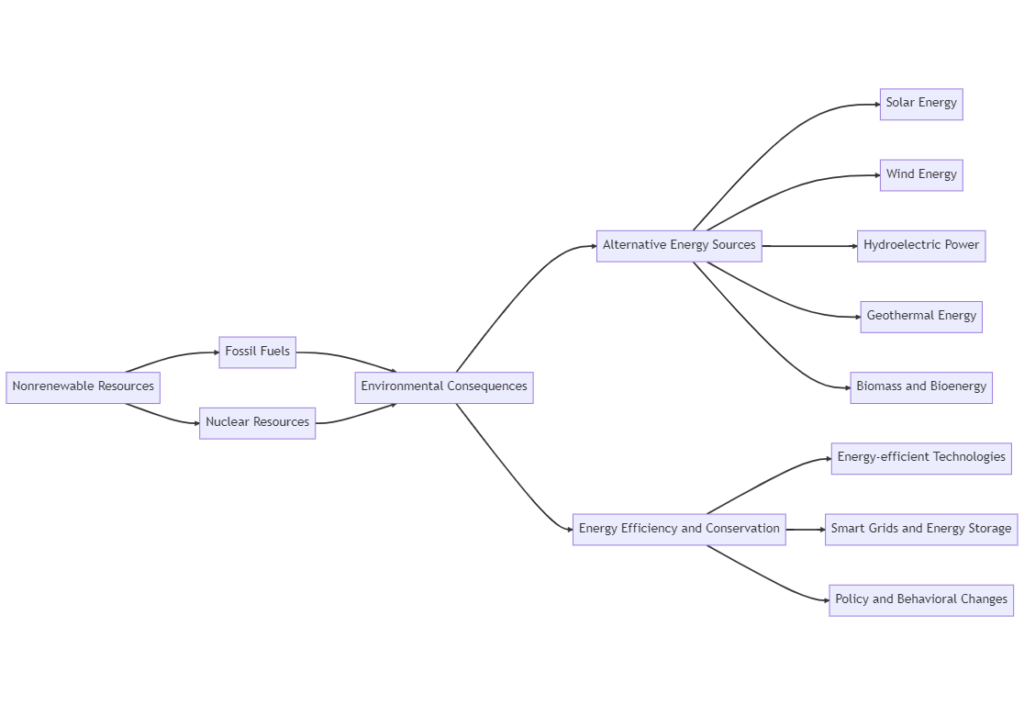Nonrenewable resources are finite and irreplaceable, and as such, their consumption poses significant challenges for our planet. In this article, we’ll delve into the various types of nonrenewable resources, examine their environmental impact and socioeconomic implications, and explore sustainable alternatives and alternative energy sources to help mitigate the negative impacts associated with their use.
Types of Nonrenewable Resources
Fossil Fuels
- Coal: Ancient plant material, over millions of years, forms coal—a combustible black or brownish-black sedimentary rock. People primarily use coal for electricity generation and steel production.
- Oil: Marine plants and animals leave behind remains that turn into liquid hydrocarbons, known as oil. This versatile resource serves various purposes, including transportation, heating, and manufacturing of products like plastics and chemicals.
- Natural Gas: Composed mainly of methane, natural gas is a colorless and odorless gas used for heating, cooking, and electricity generation.
Nuclear Resources
People harness uranium, a heavy metal, for nuclear power production. Uranium undergoes nuclear fission, a process where its atoms split and release large amounts of energy as heat. This heat is then utilized to generate electricity.
Environmental and Socioeconomic Consequences of Nonrenewable Resource Consumption
Air Pollution and Greenhouse Gas Emissions

The combustion of fossil fuels releases significant amounts of carbon dioxide (CO2), sulfur dioxide (SO2), nitrogen oxides (NOx), and particulate matter, which contribute to air pollution and climate change.
Resource Depletion and Geopolitical Tensions
The finite nature of nonrenewable resources leads to increased competition for their access and control, often resulting in geopolitical conflicts and economic disparities between resource-rich and resource-poor nations.
Health Risks
Exposure to air pollution from nonrenewable resource consumption can lead to respiratory and cardiovascular diseases, as well as premature death.
Environmental Degradation
Extraction and processing of nonrenewable resources often result in habitat destruction, soil erosion, and water pollution, jeopardizing ecosystems and biodiversity.
Harnessing Alternative Energy Sources
To mitigate the negative impacts of nonrenewable resource consumption, a transition to cleaner, sustainable energy sources is essential.
Solar Energy
People harness solar energy by converting sunlight into electricity using either photovoltaic (PV) cells or concentrated solar power (CSP) systems.
Wind Energy
By converting the kinetic energy of wind into electrical power with wind turbines, people capture wind energy.
Hydroelectric Power
Generating hydroelectric power involves harnessing the gravitational force of flowing water to produce electricity, typically through constructing dams or run-of-the-river systems.
Geothermal Energy
People derive geothermal energy from the Earth’s internal heat and use it to generate electricity or provide heating and cooling for buildings.
Biomass and Bioenergy
Organic materials, such as plant and animal waste, serve as sources for biomass and bioenergy, which can be converted into electricity, heat, or biofuels.
Promoting Energy Efficiency and Conservation
In addition to shifting toward alternative energy sources, improving energy efficiency and promoting conservation measures are crucial to reducing our reliance on nonrenewable resources.
Energy-efficient Technologies
Adopting energy-efficient technologies, such as LED lighting, high-efficiency appliances, and electric vehicles, can significantly reduce energy consumption and associated emissions.
Smart Grids and Energy Storage
Smart grids and energy storage solutions help to optimize energy usage and integrate renewable energy sources more effectively into the grid.
Policy and Behavioral Changes
Governments, businesses, and individuals all have a role to play in promoting sustainable energy practices. Policy initiatives, such as carbon pricing, renewable energy incentives, and energy efficiency standards, can encourage the transition to sustainable energy systems. Additionally, behavioral changes, such as adopting energy-saving habits and supporting sustainable businesses, can contribute to a reduction in nonrenewable resource consumption.
The Path to a Sustainable Future
The challenges posed by our dependence on nonrenewable resources require a concerted effort to transition to cleaner, more sustainable energy sources. By harnessing alternative energy, improving energy efficiency, and promoting conservation measures, we can mitigate the environmental and socioeconomic impacts of nonrenewable resource consumption and pave the way for a more sustainable future.

This diagram illustrates the relationship between nonrenewable resources, their environmental consequences, and the various alternative energy sources and conservation measures that can help mitigate these impacts.
Frequently Asked Questions (FAQs) about Nonrenewable Resources
What are five nonrenewable resources?
Five common nonrenewable resources include:
- Coal
- Oil (petroleum)
- Natural gas
- Uranium (for nuclear power)
- Tar sands
These resources are finite and take millions of years to form, making them nonrenewable.
What are renewable and non-renewable resources?
People can replenish renewable resources naturally within a relatively short period, examples include sunlight, wind, and biomass. These resources are sustainable and environmentally friendly alternatives to nonrenewable resources.
Non-renewable resources exist in finite quantities and cannot be replenished within a human timescale. Resources like fossil fuels and nuclear power are often linked to negative environmental and health impacts.
What are 5 examples of non-renewable and renewable resources?
Non-renewable resources:
- Coal
- Oil (petroleum)
- Natural gas
- Uranium (for nuclear power)
- Tar sands
Renewable resources:
- Solar energy
- Wind energy
- Hydroelectric power
- Geothermal energy
- Biomass and bioenergy
What are the 3 main non-renewable resources?
The three main non-renewable resources are:
- Coal
- Oil (petroleum)
- Natural gas
These fossil fuels are the primary energy sources for transportation, electricity generation, and industrial processes, but their combustion leads to significant greenhouse gas emissions and air pollution.
What are the most non-renewable resources?
The most prominent non-renewable resources are fossil fuels, which include coal, oil, and natural gas. These resources are non-renewable because they take millions of years to form and are being consumed faster than they can naturally replenish.
What is the cleanest non-renewable resource?
Natural gas is often considered the cleanest non-renewable resource among fossil fuels. When burned, it produces fewer greenhouse gas emissions and air pollutants compared to coal and oil. However, natural gas is still a non-renewable resource, and its extraction and use contribute to environmental degradation and climate change.